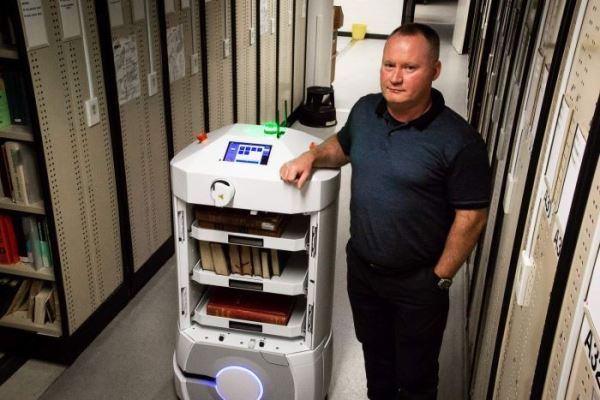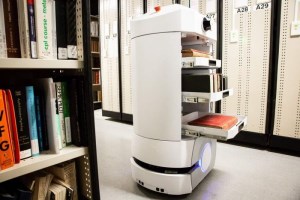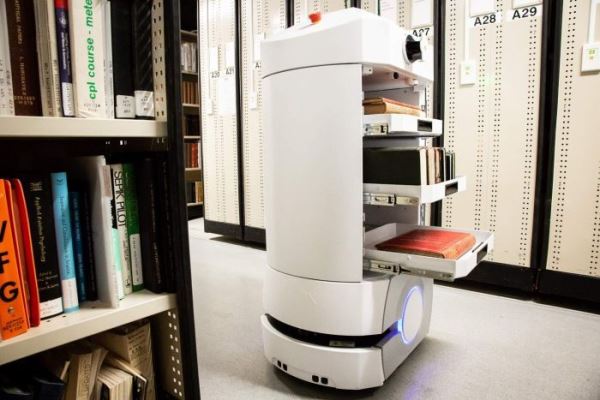You wouldn’t read about – the National Library of Australia has joined the robotic revolution.
Australia’s biggest library, based in Canberra, has deployed a fleet of high-tech robots to assist staff.
Installed by Lamson Concepts, the Omron LD-105CT “Cart” mobile robots are fitted with three shelves to cart books around the library's sprawling basement.
A large proportion of the library's collection is stored below ground and comprises century-old texts, maps, overseas material and other archives.
The Autonomous Intelligent Vehicles (AIVs) are programmed to carry material to the book lift which then delivers the articles to librarians and visitors upstairs.
They can also speak to warn people of their approach and explain their programming when tour groups visit the lower levels. Or they can play programmed music if required.
"I work together with the humans and the library stacks to transport items up to the reading rooms as quickly as possible," one robot explains.
"I also have laser and sonar sensors so that I can navigate narrow doorways and obstacles."
The four AIVs have been nicknamed Isaac, after physicist Sir Isaac Newton.
Helping staff work more efficiently
Just as the robots obey Newton's laws of motion, they also work safely and seamlessly with the librarians in the bowels of the library.
But there is no danger of the mobile robots replacing librarians. The Isaacs are designed to carry out the mundane manual tasks, to help staff work more efficiently.
The origins of the National Library of Australia go back to the early years after Australian Federation in 1901.
At that time the Commonwealth Parliamentary Library served both Federal Parliament and the nation. In 1927 the Library was moved from Melbourne to Canberra with the relocation of Parliament.
An Act of Parliament in 1960 formally separated the National Library from the Parliamentary Library and a new building for the National Library’s growing collections and services was opened on the shores of Lake Burley Griffin in 1968.
Stack attendant Paul Norden said they saved workers at least an hour's labour each day.
Travelling 5km a day
"Since these came in they've travelled over 2,000 kilometres or over five kilometres a day," he told the ABC.
"Sending the books to the lift is one trip and collecting them is another.
"So, in fact the people would be coming backwards and forwards twice."
An older model mobile robot named Charlie has been taken out of circulation at the library.
"They had a more difficult interface than this and were a bit more complicated to use," Mr Norden said.
"A decision was made to change and update,” Norden said.
And Lamson Concepts, a Sydney company specialising in mobile robots for the healthcare industry, recommending using the Omron LD series mobile robots.
Unlike traditional autonomously guided vehicles (AGVs), the LD series robots require no facility modifications, such as floor magnets or navigational beacons.
Regular courier duties
Sophisticated software and vision system allows the robots to intelligently navigate around people and unplanned obstacles. The robots can transport payloads up to 100kg.
The Isaacs have been programmed to carry out regular courier duties at the library.
"Collecting material, working on the catalogue and refiling all takes a lot of work," Mr Norden told the ABC.
"Instead of people having to move backwards and forwards 10 or 20 times a day, we can use these."
Visitors to the library, especially children, are mesmerised by the new robotic helpers.
"Kids always seem very interested in coming down and seeing the robots," Mr Norden said.
"They like to say hello when they come over and goodbye when they go away."
"We can program them to say pretty much anything."
Positive attitude from robo-colleagues
So far, the Isaacs have fit in well with the librarians' existing work.
A seldom-used red emergency button can be pressed to halt the robots and move them manually.
The only jarring thing about them is the juxtaposition of the old texts with their pristine white drawers.
Mr Norden said the attitude of other workers to their robo-colleagues had been positive.
"You don't notice them most of the time, actually.
"You hear them coming and going but they sort of work in seamlessly."
Paul Norden … ‘you don’t notice them most of the time’


